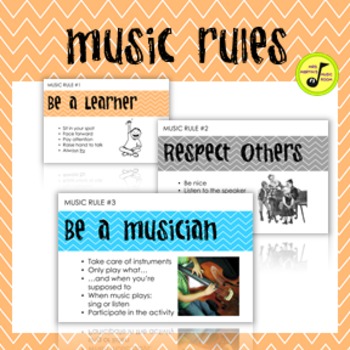In my music room, there are three main rules with 4-5 specific bullet points under each.
How many rules should I have?
Many sources say the perfect number of rules is short, between three and five. Lumping all your expectations into three rules means the rules must be vague and open to interpretation. However, practice tells us that kids need to know the specific, concrete expectations they are being held to. My solution was to have three “main” rules with descriptive bullet points under each.
 Music Rule #1: Be a Learner
Music Rule #1: Be a Learner
We are at school to learn. Learning is a lifelong sport and the most important thing you will do here. These behaviors help prepare your brain to learn. In order to learn in this room, you must:
- Sit in your spot
- Face forward
- Pay attention
- Raise hand to talk
- Always try
I give a little one- or two-sentence description of each bullet point and what it means. We practice the bullet points as we go. I scan the room to make sure they are following the rules. If anyone breaks or forgets, I go back to the beginning and start over. This sets up the expectation that rules are to be followed and you will enforce it if they’re not.
At this point, I don’t mention consequences. Most students don’t need to know what the consequences are; they are motivated to follow the rules simply because they want to be good and earn approval. The students who do need to know the consequences in advance tend to be the ones who will test the rules to see if you are really going to apply those consequences. (And you better apply those consequences!)
This means you have to be nice to other people and their property: classmates, teachers, building staff, school property.
- Be nice
- Listen to the speaker
- Use positive words
- Keep hands and feet to yourself
- Allow others to learn
I explain that “the speaker” means the person who is talking, not a device that is amplifying music! It is hard to explain what “positive words” means, but I always give examples of what negativity looks and sounds like: whining, not trying, saying “this is dumb,” or the worst, “I can’t.” We also discuss how following Rule #2 allows others to follow Rule #1.
This is the third rule because it’s the third most important. After you have readied your mind to learn and shown respect to others, then you are ready to participate in music.
- Take care of instruments
- Only play what…
- …and when you’re supposed to
- When music plays: sing or listen
- Participate in the activity
I explain that when music plays, I will usually tell them if they’re supposed to be singing or listening. They rarely have a choice between the two. However, talking is definitely not an option. The final bullet point is one that is very close to my heart. I don’t care how good you are, I care how hard you try. After all, you can never learn to shoot a basket if you don’t pick up a basketball. You can never learn to read if you don’t touch a book. And you’ll never learn music if you don’t try. If a student has a really stinky attitude, I resort to “yes, you have to do this.” But most of the time a simple reminder that participation and effort are the expectation is enough.
How should I teach the rules?
Each fall, I go over the rules with each class so they know what the rules are. The older kids already know me and my expectations so this goes very quickly, usually less than five minutes at the beginning of the first class. For the middle grades (1-3), I have student volunteers demonstrate the wrong and the right way to perform each expectation. For the very young (pre-K and K), I just read the rules and bullet points slowly, demonstrate them myself, and scan the room to make sure the kids are following them.
Later in the year, the rules are revisited only as needed. I’ve found that Kindergarten typically needs a “rules day” two more times during the year. Pre-K usually doesn’t need reminders of the rules because reinforcement and rewards are naturally built into every activity we do. For older grades, I may simply state the name of the rule (“Donovan, be a learner”) or point to the poster.
Thanks for reading! What rule is the most important to you? Answer in the comments below!
Note: The content in this article is copyrighted. Please visit TeachersPayTeachers.com for your own digital copy of Mrs. Martin’s Music Room Music Rules Posters.



